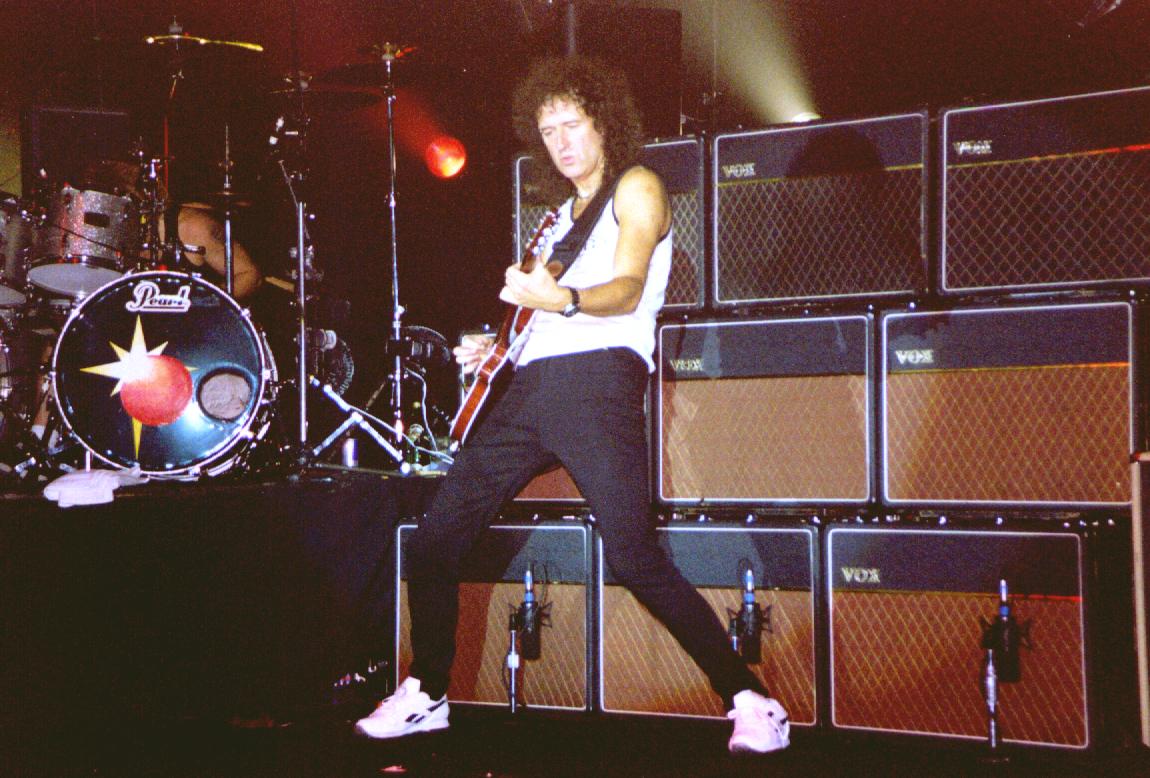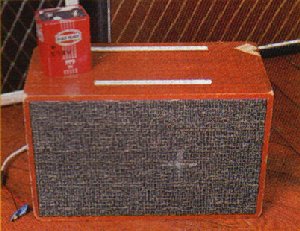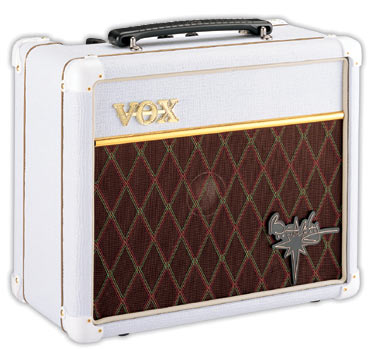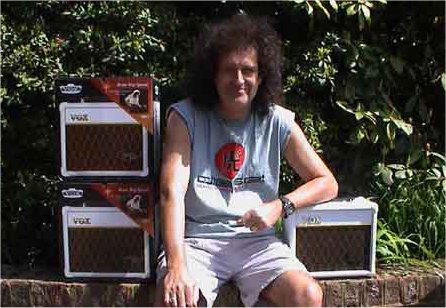
Red Speecial
Vox Deacy Amp - a review
- written exclusively for www.brianmayworld.com -
The Vox VBM1 ‘Deacy Amp’ – An Critical Opinion of the Amplifier, its Sounds, and Features
by Mark Barnett, aka Yogi, (UK)
´Introduction – 1971, ‘The Deacy Amp’
Anybody that has seen Brian May perform live, either during the Queen years or more recently during his solo-project tours, will have certainly noticed three ‘May trademarks’ which he has always utilised since his ‘arrival’ on the international music scene in 1973.
These three trademarks are of course, the curly hair, home made ‘Red-Special’ guitar, and a wall of anything up to fifteen Vox AC30s (twelve AC30s were normally employed but for the 1986 Magic Tour, a further three were used).

Brian May, performing live during the ‘Another World’ Tour,
ably supported by several examples of his favourite amplifier, the
Vox AC30, and his two other trademark items!
(the position of the three microphones in the above image shows
clearly which of the Vox amplifiers are sent out to the PA system, for
dry/delay/delay sounds during ‘Brighton Rock’ moments)
Although the hairstyle probably has little to do with Brian’s guitar tone, Brian’s Red-Special guitar and the Vox AC30, combined with his treble-booster pedal have always been his equipment choice in creating the distinctive Brian-May sound as heard on all of May’s recordings and live performances. (For a more in-depth analysis of this particular combination of equipment see www.brianmayworld.com/BrianMaysound.htm)
Due to Queen’s large recording catalogue there are many examples of this sound, however some of the clearest examples are to be found where the guitar is more prominent in the overall mix, such as Tie Your Mother Down (introduction), The Hero, One Vision, and Hammer to Fall.
Those of us with a more sharply tuned ear may have noticed that occasionally, there appears to be a very different sort of solo guitar tone that Brian has utilised, a much thicker smoother and creamier sound.
And to those of us to which this tone has passed us by unnoticed, the best examples of it can be heard on:
My Fairy King (Introduction), Procession (Entire piece, multi-tracked guitar), Fairy Fellers Masterstoke (all of the guitar orchestration accompanying the piano), Lazing on a Sunday Afternoon (harmony guitar solo), Good Company (Jazz Horns – actually a guitar!), Millionare Waltz (solo section, and guitar orchestration accompaniment), Dreamer’s Ball (song opening using guitar orchestration), Flash Gordon (guitar orchestration following vocal-line ‘Saviour of the Universe’!), Hard Life (large multi-tracked guitar chords at solo opening), Delilah (guitar solo), Bijou (guitar solo, although a little lost amongst heavy use of reverb and delay), A Winter’s Tale (guitar solo), Business (large multi-tracked guitar chords at songs beginning), and finally and perhaps most famously God Save the Queen (Entire piece, multi-tracked guitar), and the Wagner Wedding March from Flash Gordon (also the Entire piece, multi-tracked guitar)
Most of the above examples, in addition to being amongst the clearest examples of Brian’s ‘alternative’ tone, have another factor in common – they have all appear to have large amounts of multi-tracked, layered guitar orchestration parts.
This alternative tone, which proved to be exceptionally useful for producing multi-tracked recordings results from all of the above parts being recorded not using a treble-boosted Vox AC30 amplifier, but by a tiny homemade amplifier created in 1971 by Queen bassist John Deacon.
Although Queen’s first album, the self-titled ‘Queen I’ was not released until 1973, Queen in its final form had been playing together since 1971 with John Deacon being the final member to join. Deacon, a recent graduate of electronics from Imperial College London quickly noticed May’s enthusiasm for producing multi-tracked guitar harmony parts after hearing a very early rendition of ‘Procession’ that May had recorded at home on a small homemade amplifier that Brian himself had built.
Hence, a few months after joining the group, Deacon arrived for a Queen practice with a gift for Brian, a small 0.45 Watt RMS amplifier assembled from an old bookshelf speaker with electronics from a car-radio, all salvaged from a refuse-skip.
Whether by accident or
design, when combined with the Treble-Booster and Red-Special Guitar, John’s
new amplifier produced a very pleasing tone which May found to be perfect
for guitar multi-tracking; subsequently it has been used on virtually all
of May’s work since 1971. Giving due reverence to its creator the little
amplifier became known as the ‘Deacy’ Amp.

The Original 1971 Deacy Amp.
In 1997 during the Red-Special restoration project, Greg Fryer with help from Dave Peterson examined the original 1971 Deacy in detail and built two Deacy amplifier replicas as spares for Brian (in the same sense as his Red-Special replicas gave Brian spare guitars).
However, apart from Greg, very few people have either examined the circuit and construction of the Deacy or played it and been directly able to sample its unique tonal characteristics, free from the additional processing always associated with recordings.
However, a little information is available. The amplifier section of the unit was salvaged from a car-radio of 1960s vintage. It includes both a pre-amplifier and power-amplifier section both incorporating germanium-based transistors.
The power-amplifier uses a pair of the transistors in push-pull mode (or Class B in Valve-amplifier terminology) and is impedance matched to the 4 Ohm load of the two speakers found in the ‘bookshelf speaker’ cabinet by using a small transformer. The pre-amplifier is a simple 1960s Mullard-derived solid-state circuit, where transistors directly replace what would have previously been two pre-amplifier valves, one transistor acting to multiply the input signal (pre-amplifier), and the second then providing further amplification to drive the power-amplifier (driver).
The amplifier, which is powered by a large battery (as shown in the picture above) has no controls whatsoever, gain, volume or tone. In order to produce the overdriven guitar tones, Brian uses a Treble-Booster to drive the input of the Deacy. The large input signal into the amplifier coming from the booster causes it to quickly and totally distort and produce gain-levels which in modern terms due to their smooth creamy nature are frequently described as ‘liquid’, and it is this tone that is heard on the examples above. The only ‘control’ of tone for the Deacy is a piece of cloth that can be draped over the front, smoothing if necessary any high-treble response in the amplifier.
The Original Deacy amplifier was last used for recording on May’s 1998 album release, ‘Another World’. Despite its age, fragile condition, and the current difficulty in obtaining any of the 1960s-vintage electronic components in case of repair, Brian attempted to use the amplifier in a live-context for the ‘Another World’ tour. However, although clearly wanting to be able to replicate live some of the guitar tracks utilising the Deacy amplifier, the lack of any traditional amplifier controls or modern niceties such as ‘Direct-Recording-Outputs’ made it just too difficult to handle in a live format.
Nevertheless, these difficulties gave Brian May a clear idea for a new amplifier product, and he approached Vox (of course), with this idea. Could Vox create a new Deacy amplifier for him, which by utilising modern widely available electronics would sound identical to the original Deacy but would be more reliable, mains-powered thus eliminating the need for a rare battery type, have a built-in Treble-Booster tuned to give the required tonal characteristics, and possess some capability for tonal variation outside of the use of a piece of cloth?
Well, after almost one
year’s development and many prototypes, in March 2003 after 30 years of
Brian’s patronage of Vox amplifiers the first Brian May Signature Vox amplifier
was made commercially available, and it is not an AC30….
2003, ‘The Vox Deacy
VBM1’
The Vox VBM1 is the final result of a year-long collaboration between Brian May and Vox, with the aim to produce a small Deacy sounding amplifier which gives all the tonal characteristics of the Deacy, but also with some of the more modern amplifier characteristics described above. One final consideration that Brian also insisted upon was that it must be affordable, with the current street price of the unit at around 200 US Dollars/Euros, or 140 UK Pounds.
Over the remainder of the article, I will aim to give an objective opinion of the new amplifier, its construction, features, sound and value-for-money.


The Vox VBM1 – ‘Deacy Amplifier’ and Control Panel.
(Images courtesy of Vox Amplifiers, UK)
Construction
The Vox VBM1 has been constructed to quite excellent standards considering its price. By using white tolex with gold trimmings including gold screws, the amplifier is quite distinctive in looks, the Vox logo finishing what looks similar to a small AC15.
The layout is typical Vox, with the single 6½-inch speaker positioned at the front-bottom of the unit behind the usual Vox trademark three-colour diamond-weave speaker covering whilst the control panel as shown above is placed on the top of the unit. Although the control panel does not face the rear of the unit, as is normal with the AC30s (dating back to the early AC30 years where the amplifier sat in front of the guitarist facing the audience, and hence a rear-facing control panel was sensible), the chicken-head knobs further reinforce a traditional Vox appearance.
The tolex is neatly applied on all faces of the enclosure and appears to be more secure under the gold-coloured piping, another Vox trademark, than some recent AC30s I have noticed.
As the unit is mains-powered,
a power lead emerges neatly out of the rear of the enclosure. Provided
for the safe and tidy storage of this cable is a small velcro loop, into
which the power-cord can be coiled.
Features
Due to the scarcity of the many of the electronic components in the original Deacy amplifier especially the virtually unobtainable germanium transistors, Vox’s task in the creation of a Deacy amplifier replica had to be to create an amplifier which used modern silicon transistors but nevertheless reacted and sounded like a germanium-based unit. Also, as the Deacy amplifier is never driven directly from the guitar, but instead from a Treble-Booster the tonal characteristics that the Treble-Booster unit adds to the Deacy had also to be taken into account and incorporated into the amplifier.
Hence, the unit includes additional components which seek to impart on the silicon transistors germanium-transistor characteristics. It is interesting to note that germanium transistors are still widely available (for example, the AC128 being a germanium transistor commonly used in ‘Rangemaster Treble-Booster’ copies), but relatively expensive. It is quite surprising that Vox decided to invest time trying to design a germanium-transistor simulator, when the genuine articles (although perhaps not the exact type as the original Deacy) are still available. Output power from the silicon-transistor power-amplifier is 10 Watts RMS.
To provide the Treble-Booster characteristics, an actual Treble-Booster is included in the amplifier. This can be activated by the use of a Gain-switch, the ‘High’ position adding the booster into the pre-amplifier circuit.
Another emulation circuit Vox have added seeks to try and simulate the effects of using a battery-powered amplifier, driven by a battery-powered treble-booster. As almost all of modern guitarist equipment is mains-powered, little consideration nowadays is given to the use of batteries. However, batteries can impart a quite distinctive tonal character on an amplifier, as they provide a smooth delivery of current (quite analogous to the use of a valve rectifier in an AC30 for example), and as long as the battery is fresh little variation in the supplied voltage with only a small noise addition to the final tone. This latter characteristic is particularly important. When Mr Peter Cornish was providing the technical support on Brian May’s equipment, Peter noticed that the single most important factor in ensuring that amplifiers sound and react the same in all venues was the reliability, final operating voltage and smoothness of the mains-power at the concert venue. Hence, Peter and constructed a special rig to power the AC30s and ensure consistency of tone.
The amplifier also features a volume control (with the 0.45 Watts RMS output of the Deacy amplifier marked by a star), and a tone control. The latter is particular interesting. Unlike most amplifier tone controls which are passive and simply filter out the treble-end of the tone, an active tone control provides both a treble-boost or cut (along with an off-position, or ‘0’ position, which is the position required for the Deacy tone emulation), and this provides a wide range of tonal colours.
A final emulation is used in the single 6½-inch speaker. According to Vox this speaker has been ‘custom-voiced’ so that it can emulate the combined tone of the two speakers (one woofer, one tweeter) found in the original Deacy.
To further add to the
unit’s versatility, the top panel gives three outputs. The first of these
is a Treble-Booster output, where the treble-boosted signal can then be
sent straight to the input of another amplifier. Secondly a ‘Recording-output’
provides the guitar tone post-power amplifier, but importantly before the
internal speaker. Finally, a ‘speaker-out’, which when used disables the
internal speaker and which can be used to drive any 8 Ohm-or-greater-impedance
speaker cabinet.
Sound´
As stated earlier, few people have had the honour to experience the Deacy amplifier directly. However, Mark Reynolds has! Mark has described the amplifier as sounding and reacting: ‘like a small AC30’, with ‘almost infinite sustain’.
This description is perhaps unsurprising as in Greg Fryer’s opinion and 70% of the characteristic Brian-May tone originates from the Red-Special guitar plus Treble-Booster combination, with either the Deacy amplifier or AC30 contributing the final 30% of the tone. This means that the Red-Special guitar plus Treble-Booster combination is very dominant in the overall tonal mix and perhaps explains why the Deacy amplifier, used with the Red-Special guitar and treble-booster also sounds similar to an Treble-Boosted AC30 (also being played using the Red-Special).
However, for those who have not personally experienced or played the Deacy amplifier the many examples given above from Queen’s and Brian’s recording catalogue allow us to at least sonically experience it.
The inclusion of a pre-amplifier gain-control, Treble-Booster defeat, tone control and volume control gives the amplifier a degree of flexibility and tonal variation that the original Deacy does not possess. So included in the excellent manual for the amplifier is a ‘Suggested-Settings’ table which when the above controls are set to specific positions enables the Vox to sound ‘identical’ to the Deacy:
“To sound exactly like Brian’s homemade Treble-Booster/Deacy set-up, here are the settings: GAIN control on full, Gain Switch in the HIGH position, Tone control in the centre “0”, Volume Control at “Star””
Vox VBM1 Manual, Page 6
As part of the marketing for the Vox VBM1, a demonstration track based loosely upon the 1976 ‘Millionaire Waltz’ track is available for download. (http://brianmaynews.com/brian/voxbmspecial/08bmspecialvoxdemo.mp3)
This demonstration track gives a good idea of the tone of the VBM1 when set to the above recommended settings to give a tone ‘identical’ to that of the Deacy.

Brian, in his backgarden, immediately after receiving his VBM
(Images courtesy of http://www.brianmaynews.com/)
Although the Vox demonstration track is meant as merely a ‘simile’ track to Millionaire Waltz with its multitasked guitar parts providing a waltz time signature in the background, what is clear from the demonstration is the tone of the Vox VBM1 when the controls are set to emulate the Deacy does not sound like the Deacy that we are familiar with from all of the Brian May recordings. Instead the tone is considerably thinner and possesses a high-frequency fizz.
However, by using the ‘Speaker-Output’ to bypass the VBM1 speaker, the unit comes alive and sounds quite phenomenal with the controls set for Deacy-tone, giving it a very convincing AC30 tone, especially when using speaker cabs with Celestion Greenback or Celestion Blue speakers.
Hence, although the 6½ inch speaker has been custom-voiced to match the tone of the two speakers in the original Deacy, when the amp is set for Deacy-tone the speaker is not correctly voiced to provide the required full rich warm sound. As a further test of the ‘custom-voiced’ 6½ inch speaker a comparison between three Vox VBMs all set for Deacy-tone was made and a considerable difference in the tone could be heard. However, all three amplifiers were still fizzy-toned and cold sounding when set in Deacy-mode. Hence there is considerable variation in the quality of the speakers being used, and it is therefore recommended that the Vox VBM1 be auditioned prior to purchase to ensure that a reasonable tone is obtained.
However as the amplifier does have an active tone control, the tone can be easily adapted: Add a little more volume, back off the tone control into its negative range, add a guitar neck pickup with the guitar tone control also backed off and the amplifier is transformed. Now the tone is much smoother and sweeter, despite the tone-control being rolled off the amplifier still possesses enough gain to provide the infinite sustain provided by the original Deacy. This setting of the tone control sounds quite Deacy-like using the VBM1’s internal speaker, but perhaps too warm when used with a quality external speaker which needs the tone-control closer to the ‘0’ (or Vox’s Deacy) setting.
Many examples of the Vox VBM1 can now be found; some of the best ones are courtesy of Lari-Lure. Unfortunately, Lari does not describe his VBM1 tone control setup, or guitar setup, or recording setup.
This is an important omission
when recording with this amplifier as although the internal speaker can
sound fizzy, it is possible to produce a smoother warmer sound by backing
off the tone control, and this could then be recorded using a microphone.
However, these samples could also have been recorded by using either the
‘speaker-out’ to drive another high-quality speaker which is then recorded
with a microphone, or by employing the ‘recording-output’. Nevertheless,
the tone that Lari has coaxed out of the VBM1 when coupled with his Red-Special
guitar is quite stunning:
See www.geocities.co.jp/MusicStar-Keyboard/3098/deacy.mp3 for Lari’s ‘Soundcheck’, performed before recording.
Final thoughts go to the
Treble-Booster output; when this output is used the amplifier is muted
and the tone and volume controls have no effect on the tone. Used to drive
the normal channel of a Vox AC30 the resulting tone is not as quite as
good as either Brian’s current favourite Fryer boosters or his previously
used Pete Cornish examples, seeming to lack drive and sound a little thin.
However, it does provide a further tone for people using treble-boosted
AC30s.
Value for Money
The Vox VBM1 currently retails around 200 US Dollars/Euros, or 140 UK Pounds. There are around this price range many other small ‘practice amplifiers’, some of which also offer built-in digital effects units. Against these amplifiers, the VBM1 which has no digital effects and limited tonal variation may appear to be poor-value for money.
However it must be remembered, the VBM1 has been designed for a very specific purpose which almost no other amplifier regardless of price can perform – guitar orchestration. In this role, it does perform extremely well. When correctly set-up, whether used for multi-track guitar or not, it can produce an extremely sweet full tone.
That and all the extra features such as treble-booster
output and direct recording-output, make this amplifier good value for
money.
Conclusion
This is quite an interesting
amplifier; it is constructed to produce a quite unique sound, has quite
novel emulation circuits for the amplifier and power-supply, many different
tones courtesy of the active tone control and a speaker choice from thin
and fizzy for the internal speaker, to whatever sound you require due to
the speaker-out facility.
That this tone can then be easily and convincingly recorded either by microphone onto the internal speaker (although taking care to ensure the tone is not fizzy), or more easily using the fuller sounding ‘Direct-Recording-Output’ gives it great potential for a recording amplifier, as is the original Deacy.
Furthermore, using the ‘Speaker-Output’ alone into a quality speaker cab, the sound is quite phenomenal. For those to whom a owning an AC30 is just a dream, the sound of this amplifier through a quality cab will go a long way to producing the Brian May sound.
Unfortunately, its complexity and versatility can also be its downfall. The original Deacy, with no tone controls, is a very simple amplifier but it always delivers the tone May requires with little setting-up. The Vox VBM1, especially due to the internal speaker can be made to sound very un-Deacy like. However, as Lari-Lure clearly demonstrates if you use your ears and adjust the sound ‘to-taste’ this can be a wonderful sounding amplifier.
Highly recommended.
The author wishes to
thank Oliver Tamminga, Mark Reynolds, Lari-Lure and Julian Hemingway for
their help in the preparation of this article.